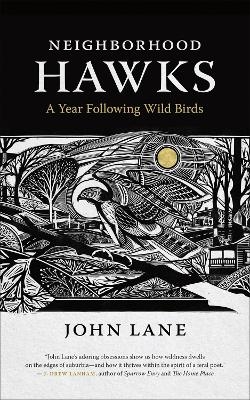
Neighborhood Hawks
A Year Following Wild Birds
Seiten
2019
University of Georgia Press (Verlag)
978-0-8203-5493-4 (ISBN)
University of Georgia Press (Verlag)
978-0-8203-5493-4 (ISBN)
Follows in the tradition of writings from Henry David Thoreau, Terry O'Connor and J.A. Baker, with John Lane using the red-shouldered hawks that live in his neighborhood to explore the concept of “commensalism”, the idea that two species can live near each other without harming or benefitting the other.
After reading J. A. Baker’s fifty-year-old British nature classic The Peregrine, John Lane found himself an ocean away, stalking resident red-shouldered hawks in his neighborhood in Spartanburg, South Carolina. What he observed was very different from what Baker deduced from a decade of chronicling the lives of those brooding migratory raptors. Baker imagined a species on the brink of extinction because of the use of agricultural chemicals on European farms. A half century later in America, Lane found the red-shouldered hawks to be a stable Anthropocene species adapted to life along the waterways of a suburban nation.
Lane watched the hawks for a full year and along the way made a pledge to himself: Anytime he heard or saw the noisy, nonmigratory hawks in his neighborhood, he would drop whatever he was doing and follow them on foot, on bike, or in his truck. The almanac that results from this discipline considers many questions any practiced amateur naturalist would ask, such as where and when will the hawks nest, what do they eat, what are their greatest threats, and what exactly are they communicating through those constant multinoted cries? Lane’s year following the hawks also led him to try to answer what would become the most complex question of all: why his heart, like Baker’s, goes out so fully to wild things.
After reading J. A. Baker’s fifty-year-old British nature classic The Peregrine, John Lane found himself an ocean away, stalking resident red-shouldered hawks in his neighborhood in Spartanburg, South Carolina. What he observed was very different from what Baker deduced from a decade of chronicling the lives of those brooding migratory raptors. Baker imagined a species on the brink of extinction because of the use of agricultural chemicals on European farms. A half century later in America, Lane found the red-shouldered hawks to be a stable Anthropocene species adapted to life along the waterways of a suburban nation.
Lane watched the hawks for a full year and along the way made a pledge to himself: Anytime he heard or saw the noisy, nonmigratory hawks in his neighborhood, he would drop whatever he was doing and follow them on foot, on bike, or in his truck. The almanac that results from this discipline considers many questions any practiced amateur naturalist would ask, such as where and when will the hawks nest, what do they eat, what are their greatest threats, and what exactly are they communicating through those constant multinoted cries? Lane’s year following the hawks also led him to try to answer what would become the most complex question of all: why his heart, like Baker’s, goes out so fully to wild things.
JOHN LANE is professor emeritus of environmental studies at Wofford College. A 2014 inductee into the South Carolina Academy of Authors, his books include Circling Home, My Paddle to the Sea, and Coyote Settles the South (all Georgia). He is also coeditor of The Woods Stretched for Miles: New Nature Writing from the South (also Georgia), and he has published numerous volumes of poetry, essays, and novels. Coming into Animal Presence is his most recent work. He lives in Spartanburg, South Carolina.
| Erscheinungsdatum | 05.03.2019 |
|---|---|
| Reihe/Serie | Wormsloe Foundation Nature Books |
| Mitarbeit |
Karten von: Helen Correll |
| Zusatzinfo | 1 Maps |
| Verlagsort | Georgia |
| Sprache | englisch |
| Maße | 127 x 203 mm |
| Themenwelt | Sachbuch/Ratgeber ► Natur / Technik ► Natur / Ökologie |
| Sachbuch/Ratgeber ► Natur / Technik ► Naturführer | |
| Naturwissenschaften ► Biologie ► Ökologie / Naturschutz | |
| Naturwissenschaften ► Biologie ► Zoologie | |
| ISBN-10 | 0-8203-5493-7 / 0820354937 |
| ISBN-13 | 978-0-8203-5493-4 / 9780820354934 |
| Zustand | Neuware |
| Informationen gemäß Produktsicherheitsverordnung (GPSR) | |
| Haben Sie eine Frage zum Produkt? |
Mehr entdecken
aus dem Bereich
aus dem Bereich
Familien und Gattungen einheimischer Pflanzen
Buch | Hardcover (2022)
Haupt Verlag
64,00 €
Allergien bei Hunden verstehen und behandeln
Buch | Softcover (2023)
Minerva Verlag
16,90 €


